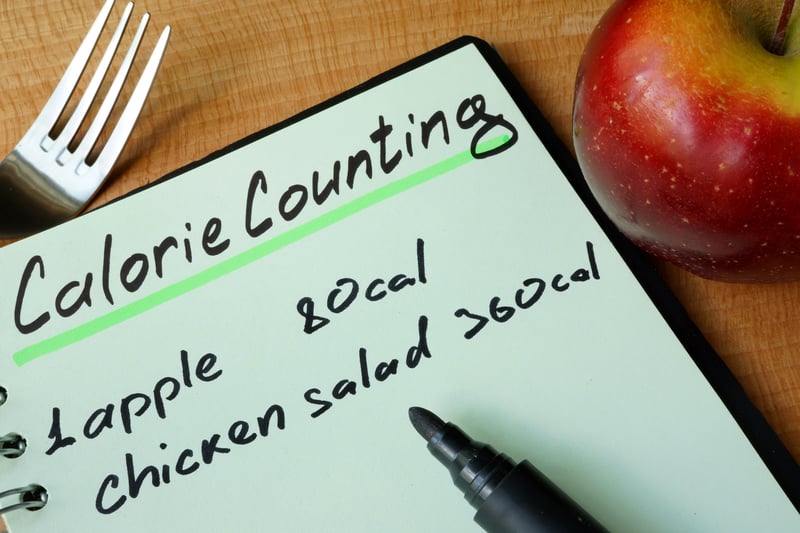Does Calorie Counting Work for Weight Loss? See the Science

“Eat less, move more.” The formula is simple: Count the calories coming in, deduct the calories going out, and if you burn more than you consume, Bob’s your uncle. Weight-loss success! But does calorie counting work like that? Is calorie counting really the best tool for losing weight?
With the popularity of so many apps that have you track everything you do and every bite you eat, you’d think the answer must surely be yes.
Of course, it is true that eating fewer calories than you burn is a proven way to lose weight, but it turns out, tracking calories isn’t just tricky, it’s imprecise and far from straightforward.
What is a Calorie?
Technically, a calorie is the energy it takes to increase the temperature of a kilogram of water by one degree Celsius. But for our purposes here, it’s simply a measure of energy. We typically think of calories in terms of the foods we eat and the exercise we do. But we also burn calories just by breathing, thinking, walking, and talking. We even burn calories by eating.
Of course, in addition to burning calories, our bodies (some more than others) are incredibly proficient at storing calories—some of it as glycogen (the storage form of carbohydrate) in the liver for our muscles but more often as body fat for the long haul. And too much storage of these excess calories leaves us overweight or obese.
How are Calories Calculated?
Scientists have spent a lot of time calculating the amount of calories found in foods. Very simplistically, they take a specific food, place it into something called a “bomb calorimeter,” seal it, and then ignite the food. As the food burns, air escapes and heats up water. The researchers then calculate the calories in the food by measuring the change in the water temperate.
Of course, we know different macronutrients have different calories per gram. For example, most of us have heard that fat has nine calories per gram while carbohydrates and proteins have four calories per gram.
While bomb calorimetry is an exceptional tool for measuring the theoretical energy potential of food, the methodology is not nearly as nuanced as the intricately engineered human body. You see, one of the biggest challenges is that calories behave differently in the body than they do in the devices we use to measure them.
Thus, we have a rather imprecise calculation for calorie counts. How a food is prepared—for example, cut up, cooked, or blended—can dramatically alter the energy availability.
And that doesn’t even begin to describe the changes in energy availability once the food enters our system. We may digest and absorb more or less than what’s written on the food label depending on our own microbiome, how well we chew and digest the food, etc.
For example, certain species of gut bacteria can harvest more calories than others. That’s right, an imbalance of gut bacteria can increase the amount of calories you extract from food.
The Problems with Counting Calories
According to Precision Nutrition, some of the challenges with calorie counting include:
- Calorie averages. Published calorie counts are averages. For example, a medium carrot may contain anywhere from 37 to 61 calories—give or take. A six-ounce filet mignon, on the other hand, could contain between 323 and 506 calories. And yesterday’s large sweet potato might have contained as few as 231 calories while today’s may be packed with as many as 705 calories!
What about the foods that come with labels? There are 5 different acceptable methods for calorie counting, and the FDA accepts inaccuracies of up to 20%.
- Calories absorbed. When looking at how many calories are absorbed, those numbers vary greatly too—by an average of 10%. For example, it’s estimated that only 68% of the calories in a serving of almonds are absorbed; meanwhile, the accepted formulas underestimate the amount of calories absorbed from fiber-rich foods like kale, which is estimated to provide up to 28% more calories absorbed. (Obviously, though, not too many people are struggling with their weight because they’re overeating kale.)
- Food preparation. Is your food raw or cooked (and how)? Chopped or blended? That doesn’t seem like it would make that much difference, but it can actually change the calorie load by up to 90%! For instance, a baked potato contains 193 calories while a raw potato only makes 101 calories available for absorption.
- Individuals are unique. What is your microbiome made of? Different bacteria can extract more calories than others, and the microbiome isn’t consistent. It changes depending on the types of foods you eat; for example, if you consume lots of probiotics and prebiotic-rich foods, your microbiome is likely to be vastly different than if you consumed predominantly heavily processed junk food. And the microbiome can even be affected by a single meal!
- Human error. Um… that looks like about a cup of pasta, a tablespoon of peanut butter, or an ounce of cheese, right? Wrong. When eyeballing portion sizes, we’re wrong about two-thirds of the time. Yeah, that’s most of the time.
- Other factors. In addition, the energy content can be affected by the amount of fiber and resistant starches, if the data is current vs. outdated, product variety, growing conditions and season, ripeness, the animals’ diet and environment, how long the product has been on shelf, and more.
That means those 150 calories you think you’re eating could actually be only 130 or up to 180. And over time, that can add up… or down.
When we try our best to calculate calories, we could be off by a good 25%. That’s far from an accurate science. Plus, calorie counting—no matter how great your app (and there are several good ones)—can take a lot of time and effort. And we haven’t even talked about calories out yet…
The Problems with Calculating Calorie Burn
You’re wearing your fitness tracker, measuring the amount of time you’re lifting weights, walking or running, doing yoga, and even charting your chores. You’ve gone online and you’ve calculated your resting metabolic rate (which, by the way, is terribly difficult to accurately determine short of using a metabolic cart or chamber). You’re set, right?
Again, according to the experts at Precision Nutrition, there are some issues with the whole calories out portion of the equation. For example…
- Imprecise calculations. The figures you see for calories expended (even those right here in this blog, in articles I’ve penned) are just estimates based on averages. You’re an individual, and depending on your weight, lean mass, basal metabolic rate, and other variables, they can be off by as much as 30%. On average, it differs by at least 10%.
- You’re uniquely you. Your genes, epigenetics (how your environment affects the expression of your genes), hormones, sleep, diet, fat variety (white vs. brown and where it’s located), and more can affect how many calories you burn while at rest and while exercising. Even your individual metabolic rate can change from one day to the next by up to 20%.
- How much you eat. Most people don’t eat the same exact types and amounts of foods from one day to the next. However, your metabolism was designed for homeostasis and, within reason, can adjust to how much you eat—burning more calories when you eat more and burning fewer when you eat less. Some people’s bodies are more adaptive than others, which is why some lucky people seem to be able to get away with more indulgences than others.
- Your personal weight history. If you were overweight at one time and lost weight, you likely burn fewer calories at your current weight than someone who had maintained that weight.
- Your NEAT. Non-exercise activity thermogenesis (NEAT), which is the component of the metabolic rate that consists of non-structured activities, can vary from one person to the next by upwards of 800 calories per day, and thus, can be a significant contributor to weight loss and gain. In other words, if you have higher NEAT, you’ll be less likely to gain weight; meanwhile, if you have lower NEAT, you may find it more difficult to lose weight.
What to Count Instead
If calorie counting is both so much work and so inaccurate, there must be a better way! Indeed, there often is. At this time, I admit I’m directly stealing from Coach Tim (with his permission, of course). Instead of focusing on every single calorie that comes in, you can use your palm as your guide to eating the right amount for your body:
- Protein. For foods like meat, fish, dairy, and eggs, use a palm-sized portion. We recommend consuming a portion of protein at each feeding. Generally speaking, a portion provides about 20 – 30 grams of protein. Men and more active folks may need two portions per feeding.
- Veggies. For veggies like greens, cauliflower, and broccoli, use a fist-sized portion. We recommend consuming 1 – 2 servings of veggies at each feeding, although there’s not really a limit per se.
- Carbs. For carb-dense foods like fruits, potatoes, whole grains, and legumes, use a cupped hand portion. Generally speaking, carbohydrate intake should be inversely proportionate to body fat (i.e., more body fat, fewer carbs) and directly proportionate to activity levels (i.e., more active, more carbs). When trying to lose weight, men typically do well with about 1 – 2 portions per meal while women seem to fair well with ½ – 1 portion per meal.
- Fats. For healthy fats like oils (e.g., olive, macadamia, avocado, and coconut oils), butter/ghee, nuts, and seeds, use a thumb-sized portion. Speaking generally, men typically do well with about 1 – 2 portions per meal while women seem to fair well with ½ – 1 portion per meal.

So, Does Calorie Counting Work For Weight Loss?
It is true that people who consume more calories than they burn gain weight, and vice versa. One study found that folks who counted calories lost, on average, seven more pounds than those who didn’t bother.
Yet years ago, I heard advice that “calories count, but don’t count calories.” And with the imprecision of both calories out and calories in (along with the other complications like accurately figuring out basal metabolic rate and NEAT), you may think those tracking tools and apps for counting all calories are a complete waste of time.
For exact calorie counting, you’re absolutely right. That doesn’t, however, make them useless. In fact, they can be very effective tools for weight loss.
What’s most effective about calorie trackers isn’t that they’re accurate. Rather, journaling your food intake and exercise can dramatically increase your awareness of what you’re actually eating and how much you’re really moving. Thus, you can see areas where you can improve. And if you start gaining or losing weight, you can see what changes are affecting your weight.
How many calories in that particular carrot matters less than the fact that you are eating more vegetables, for example.
At the end of the day, the point is not to get consumed by calorie counting. Instead, for a more surefire way to lose weight, watch your portion sizes, eat more whole foods (and less junk), exercise on the regular, get enough sleep, increase NEAT, and consume more fiber- and protein-rich foods.
From time to time, it can help to keep a log of your food and movement and how it makes you feel. It can also be a useful tool to see what’s working and what’s not. And for exercising, it helps to know that certain activities may burn more calories than others. So, if you’re pressed for time and weight loss is the end game, you can make the most out of the time you do have.
Remember, though, while calories do count, calorie counting likely isn’t the end-all, be-all for weight-loss success.







